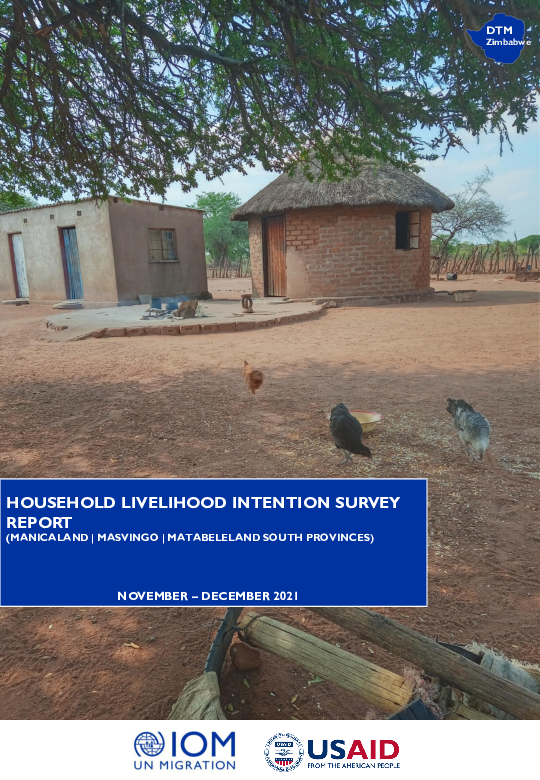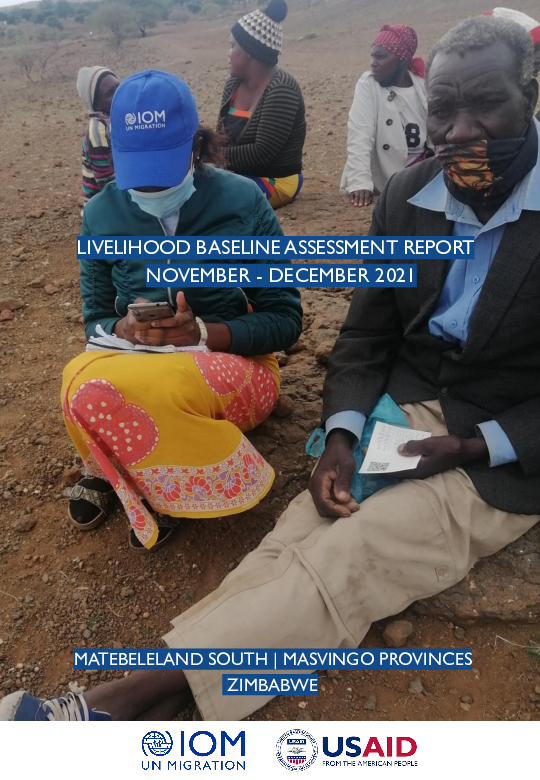-
Countries
-
Data and Analysis
-
Special Focus
-
Crisis Responses
Contact
SouthSudanDTM@iom.int
Location
South Sudan
Activity
- Site Assessment
- Mobility Tracking
Period Covered
Jul 01 2021 -Sep 30 2021
A site assessment is a sub-component of mobility tracking. It aims to collect data on population presence, living conditions and needs in a particular displacement site or community.
Population Groups
Survey Methodology
Unit of Analysis Or Observation
Type of Survey or Assessment
Keywords
Geographical Scope
Administrative boundaries with available data
The current dataset covers the following administrative boundaries
Contact
SouthSudanDTM@iom.int
Location
South Sudan
Activity
- Mobility Tracking
- Village Assessment
Period Covered
Jul 01 2021 -Sep 30 2021
Population Groups
Survey Methodology
Unit of Analysis Or Observation
Type of Survey or Assessment
Keywords
Geographical Scope
Administrative boundaries with available data
The current dataset covers the following administrative boundaries

Contact
DTM Libya, DTMLibyateam@iom.int
Language
English
Location
Libya
Period Covered
Feb 27 2022
Mar 05 2022
Activity
- Other
As part of the the second phase of the Libyan national COVID-19 vaccination campaign led by the Libyan National Centre for Disease Control (NCDC), IOM conducted awareness raising sessions on COVID-19 vaccines with a total of 624 adult migrants (124 females and 500 males) in three locations, Triq al Sika detention centre and community settings in two municipalities during the reporting period (27 Feb - 5 Mar 2022).

Contact
DTM Support, DTMSupport@iom.int
Language
English
Location
Zimbabwe
Period Covered
Nov 09 2021
Dec 01 2021
Activity
- Mobility Tracking
- Baseline Assessment
Electronic questionnaires were used to collect the data and purposive sampling was used for sample selection. Analysis of the data has been done using descriptive statistics and visualization techniques. Eighty-nine enumerators were trained on the multisectoral village assessment questionnaires as well as data collection techniques.
Multi-sectoral village assessments were conducted through focus group discussions with key informants in villages identified through baseline assessments which were conducted during the same period to capture population estimates, multi-sectoral needs, vulnerabilities and livelihood opportunities. The key informants included village heads, village health workers, childcare workers, village secretaries, chiefs, religious leaders, community members, education officers

Contact
DTM Support, DTMSupport@iom.int
Language
English
Location
Zimbabwe
Period Covered
Nov 09 2021
Dec 01 2021
Activity
- Mobility Tracking
- Baseline Assessment
IOM, in partnership and close coordination with the Government of Zimbabwe, conducted DTM household intention assessments in villages assessed during the multisectoral village assessments in Chimanimani and Chipinge districts of Manicaland province in Zimbabwe. This exercise conducted between 9 November and 1 December 2021 collected data from a total of 599 households in all two districts combined.
The following report is an analysis of the data gathered from the assessment, covering household profiles, intentions, and livelihood situations. The main objective of the survey was to better understand the intentions and living conditions of the targeted population to support recovery and reintegration efforts by providing the support needed in terms of livelihoods. However, purposive sampling was used to select beneficiaries hence the results of the study cannot be generalized to a larger
population and are indicative of trends and patterns only as the sample is not representative of the entire population in the two districts.

Contact
DTM Support, DTMSupport@iom.int
Language
English
Location
Zimbabwe
Period Covered
Nov 09 2021
Dec 01 2021
Activity
- Mobility Tracking
- Baseline Assessment
Through the inception meeting done at district level with stakeholders from the Ministry of Local Government, Housing and Public works, Ministry of Public Service and Social welfare, Ministry of Lands, Agriculture, Fisheries, Water and Rural Resettlement, Ministry of Women Affairs, Community, Small and Medium Enterprises Development, wards to be assessed were identified The baseline assessments were then conducted in the prioritized wards through focus group discussions with the ward key informants who included ward councillors, ward secretaries, village heads, extension workers, VHWs and representatives of the vulnerable groups.
Data collection enumerators recruited at district level, were trained on the administration of baseline questionnaire with data collection done through mobile devices Key informant mobilization was done through and in coordination with the office of the District Civil Protection Committee

Contact
DTM Libya, DTMLibya@iom.int
Language
English
Location
Libya
Period Covered
Dec 12 2021
Dec 18 2021
Activity
- Other
As part of the national COVID-19 vaccination campaign led by the Libyan National Centre for Disease Control (NCDC), IOM community mobilizers, accompanied by medical teams vaccinated migrants at Ain Zara detention center (DC). During the eleventh week, 256 migrants (21 females, 235 males) have received Sinopharm vaccines.

Contact
DTM CAR, DTMRCA@iom.int
Language
French
Location
Central African Republic
Period Covered
Dec 15 2021
Jan 27 2022
Activity
- Mobility Tracking
- Baseline Assessment
Ce rapport fournit un aperçu de la situation de déplacement et des conditions et besoins humanitaires multisectoriels dans les localités accueillant les populations mobiles en République centrafricaine (RCA), ayant effectué soit des mouvements de déplacement forcés, soit des mouvements de retour vers leurs zones de provenance. L’évaluation a été réalisée par l’Organisation Internationale pour les Migrations (OIM), entre le 15 décembre 2021 et le 27 janvier 2022 dans 2 416 localités d’accueil des populations déplacées internes (PDI) et / ou retournées et 72 sites d’accueil des PDI. Les localités ont été préalablement identifiées avec les autorités locales et sous-préfectorales dans chaque préfecture couverte. Les données ont été collectées au moyen de deux questionnaires structurés multisectoriels (un déployé au niveau des localités et un déployé au niveau des sites) auprès d’informateurs clés incluant des représentants de déplacés, chefs de communautés, gestionnaires de sites et travailleurs humanitaires.

Contact
DTM Mauritania, DTMMauritania@iom.int
Language
English
Location
Mauritania
Period Covered
Oct 14 2021
Nov 02 2021
Activity
- Survey
- Migrants presence
- Mobility Tracking
Ces dernières années, la Mauritanie est devenue une destination migratoire importante pour ses opportunités économiques et de travail, notamment dans la capitale Nouakchott et dans la ville de Nouadhibou, mais aussi comme étape intermédiaire sur la route migratoire vers l'Afrique du Nord et l'Europe. Ces migrations en Mauritanie concernent à la fois des personnes adultes comme des enfants qui sont parfois accompagnés de leurs parents ou d'autres membres de la famille, mais aussi d’autres enfants qui arrivent en Mauritanie sans être accompagnés.
Cependant, peu d’informations sont disponibles concernant la migration des enfants en Mauritanie alors qu’une meilleure appréciation du nombre des enfants migrants en Mauritanie, leur profil, les vulnérabilités et les besoins spécifiques de cette population dans le pays permettrait de mieux planifier une réponse appropriée à ces enfants migrants.
C’est dans ce cadre qu’une enquête a été réalisée dans plusieurs quartiers de Bassikounou, Nouakchott, Nouadhibou et Sélibaby par l’Organisation Internationale pour les Migrations (OIM), au travers le Système de Suivi des populations mobiles (Displacement Tracking Matrix, DTM en anglais). L’objectif de cette étude était de cartographier les zones à forte présence d’enfants migrants et de comprendre leurs profils (sexe, âge, nationalité, niveau d’instruction, situation familiale, etc.), les raisons de la migration, les facteurs de risque auxquels sont exposés les enfants, les besoins et vulnérabilités ainsi que les structures de protection existantes.
Contact
DTM Yemen, iomyemendtm@iom.int
Location
Yemen
Activity
- Event Tracking
- Mobility Tracking
Period Covered
Feb 27 2022 -Mar 05 2022
From 01 January 2022 to 5 March 2022, IOM Yemen DTM estimates that 3,991 households (HH) (23,946 Individuals) have experienced displacement at least once.
Since the beginning of 2022, DTM also identified 011 displaced households who left their locations of displacement and either moved back to their place of origin or another location.
Between 27 February and 05 March 2022, IOM Yemen DTM tracked 220 households (1,320 individuals) displaced at least once. The majority of people moved into/within the following governorates and districts:
• Abyan (49 HH) – Khanfar (49 HH) district. Most displacements in the governorate originated from Al Hodeidah.
• Marib (45 HH) – Marib City (31 HH), Marib (14 HH) districts. Most displacements in the governorate originated from Al Jawf and Marib.
• Shabwah (41 HH) – Ayn (19 HH), Ataq (11 HH), Radum (9 HH) districts. Most displacements in the governorate originated from Shabwah and Al Hodeidah.
The majority of people moved from the following governorates and districts
• Al Hodeidah (86 HH) – Hays (54 HH), Al Jarrahi (15 HH), Bayt Al Faqih (10 HH) districts.
• Taiz (43 HH) – Jabal Habashi (25 HH), Maqbanah (9 HH), Al Makha (2 HH) districts.
• Shabwah (25 HH) – Ayn (25 HH) district.
Population Groups
Survey Methodology
Unit of Analysis Or Observation
Type of Survey or Assessment
Keywords
Geographical Scope
Administrative boundaries with available data
The current dataset covers the following administrative boundaries